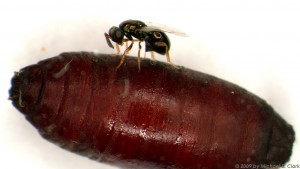Tiny, parasitic wasps are really cool. (5 reasons why I spent two years watching wasp sex)
In college, I spent two years of my life asking: when two species of wasps mate, why do their hybrid offspring die? To try and figure this out, I watched wasps have sex, counted the eggs they laid after mating, counted any adults that survived from those eggs, mated the survivors to other wasps, ground them up, and checked one of their genes to see if it was more like one of their parents or the other. After two years, I left the project and lab behind, and still had no idea why hybrid offspring die… until now.
A new Science paper demonstrates that I spent my two years looking in entirely the wrong place. It isn’t the wasps’ genes that cause their hybrid offspring to die: it’s their microbiome. Specifically, it is the types of bacteria that the mothers leave behind when they lay their eggs. When the authors added a few specific types of bacteria to hybrid eggs, almost all of the offspring survived. It’s incredibly satisfying to see this question finally answered, and the authors have also done a great job translating their work and putting out lots of resources like the original research paper in Science, a free pdf of the paper, a lecture from one of the co-authors, and a few lay-friendly posts from the authors themselves.
Reading these articles reminded me why I spent those two years doing the same thing over and over again. Of course, I was interested in learning more about how species evolve and what makes one species different from another, but I also just thought that these tiny, parasitoid wasps (called Nasonia) were really cool.
Five reasons why I spent two years watching wasps have sex

1. Some Nasonia wasps are parasites of parasites. All Nasonia parasitoids: female Nasonia wasps inject young flies with venom, halting the fly’s development. Our Nasonia wasp then lays her eggs inside of the young fly, which still in an egg-like stage called a pupa (the reddish tube in the photo below). Over the next few days, the Nasonia eggs will turn into larvae, and start feeding on the fly pupa until the male wasps are ready to emerge. Some Nasonia lay their eggs inside of blowfly pupae, which are themselves often parasites of birds, making Nasonia a parasite of a parasite in these cases.
2. Nasonia are really easy to work with. Nasonia are about ¼ of the size of Drosophila melanogaster (aka fruit/vinegar flies). In the lab, they can live their entire life inside of small tubes. Young Nasonia emerge from a fly pupae, and mate with their brothers or sisters. After mating, you can move the females into new tubes with new flesh fly pupae, allowing more Nasonia to grow, or you can slow down their development by putting the freshly-laid eggs in the fridge. At cold temperatures, they can keep for over a year! This means that you can do an experiment, go on summer vacation, and pick up right where you left off. Perfect for a college student. You can even buy your own Nasonia and try this out at home!
Video of my former head-of-lab, Jack Werren, explain each step of the mating process in these wasps. Their antennal movements are really vulgar and fantastic.
4. The hosts for Nasonia, called Sarcophaga bullata, are completely disgusting. When Nasonia fail to lay eggs in a fly pupae, the flies develop normally. In the lab, we use one particular species of flesh fly, called Sarcophaga bullata (one of my all-time favorite latin names). Adult Sarcophaga feed on liver cultures, which smells strongly of rotting meat (their natural food source in the wild), and when the flies want to get out of their pupal shells, they pulse fluid in and out of their heads to break open the hard shell, like this:
Thanks again to Jack Werren for this awesomely disgusting movie– I think I actually might have taken this one myself during my stint in the Werren lab, though I can’t be sure.
5. Nasonia are beautiful. If you have to stare at something for hours every day, it might as well be nice to look at. A former postdoc from the lab, Michael Clark, took the time to really document the beauty of these animals and the day-to-day life in the lab. You can find even more images on the Werren lab website’s image gallery, and you’ll also find links to more info on Nasonia there, too.

Disgusting, yet absolutely awesome! Thanks for the education.